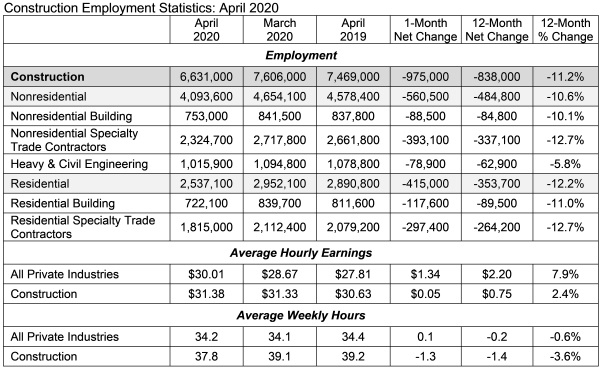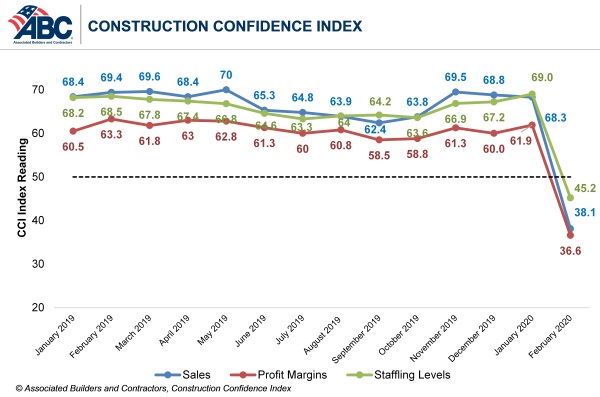Construction employment throughout the US declined by 975,000 jobs in April as a new survey by the Associated General Contractors of America and data from construction technology firm Procore show deteriorating demand for construction, officials with the association announced on May 8.
The new economic data underscores the need for new federal measures to help the construction industry recover, including infrastructure funding, safe harbor provisions and fixes to the Paycheck Protection Program guidance, association officials added.
Meanwhile, the Associated Builders and Contractors (ABC) reported that Nonresidential construction employment lost 560,500 jobs on net in April. There were job losses in all three nonresidential segments, with the largest decline registered among nonresidential specialty trade contractors, which lost 393,100 jobs. Nonresidential building lost 88,500 jobs, while heavy and civil engineering lost 78,900 jobs.

The construction unemployment rate was 16.6% in April, an increase of 11.9 percentage points from the same time last year. Unemployment across all industries rose from 4.4% in March to 14.7% last month. This was the highest rate since the BLS started tracking unemployment in 1948. Because of technical reasons related to the BLS survey and a classification error in several responses, the unemployment rate is probably closer to 20 percent, ABC reported.

Meanwhile, Ken Simonson, the AGC’s chief economist, said: “Today’s jobs report, our new survey results and Procore’s data make it clear that the construction industry is not immune to the economic damage being inflicted on our country by the pandemic.
“Without new federal help, it is hard to see a scenario where the construction industry will be able to recover any time soon,” he said.
The economist said the loss of 975,000 construction jobs from March to April constituted nearly 13 percent of the industry’s employment and was, by far, the worst one-month decline ever. He added that unemployment among workers with recent construction experience soared by 1.1 million from a year earlier, to 1,531,000, while the unemployment rate in construction jumped from 4.7 percent in April 2019 to 16.6 percent.
Simonson noted that a survey of over 800 construction firms the association released today found that while only 30 percent of firms report projects have been halted by government order – down from 35 percent two weeks ago – 37 percent say their owners have voluntarily halted work out of fears of the pandemic. Thirty-one percent report that owners have canceled projects because of a predicted reduction in demand. And 21 percent report having projects canceled as a result of a loss of private funding.
All told, 67 percent of firms report having a project canceled or delayed since the start of the outbreak in early March. These cancellations have forced some firms to cut staff. Twenty-three percent, for example, report cutting staff in March and 22 percent cut staff in April. Yet the economist said the job losses would likely have been worse if not for the federal government’s Paycheck Protection Program loans, noting that 80 percent of respondents report having applied for the loans and most having been approved.
The AGC economist cautioned, however, that recent revisions by the Treasury Department to its guidance for the loans have prompted quite a few firms to consider returning the funds. Eighteen percent of firms report they are considering returning the funds because of the vague guidance, and most of these will be forced to cut staff as a result. Simonson added that is one reason why 12 percent of firms report they plan to make additional layoffs within the next four weeks.
“Unfortunately, our survey indicates that layoffs are continuing to occur throughout the nation,” Simonson added. “Between March 1 and May 1, 39 percent of responding firms reduced their headcount. Reductions were particularly severe in the Northeast, where 53 percent of firms terminated or furloughed employees. The South had the fewest firms reporting staff reductions—29 percent, while 38 percent of firms in the Midwest and 45 percent in the West reduced headcount.”
In addition to the new survey results, the association also shared new data released by construction technology firm Procore. The data is based on the transactions logged via the company’s software by tens of thousands of construction firms across the country. That data is available here and shows how demand and hours-worked have declined in most states since the start of the pandemic. Procore also released a new blog post about the data that can be found here.
“We realized that the construction industry primarily gathers data through surveys, which can take a long time, and it’s pretty tough to get a quick visualization or snapshot of what’s going on with construction at a national and state level. So we decided to do something about it,” said Kristopher Lengieza, Senior Director of Business Development at Procore. “These insights are helping industry organizations and economists analyze trends, debate potential courses of action, and decide on the best path forward, in an effort to support the construction industry through the current pandemic.”
Simonson noted that the construction association was calling on federal officials to take additional steps to prevent additional industry layoffs. Among those steps are clarifying the guidance regarding the paycheck protection program. He also noted that 61 percent of survey respondents say Congress should enact a “safe harbor” set of protocols to provide firms that are following safe practices with protection from tort or employment liability for failing to prevent a Covid-19 infection.
In addition, 43 percent of survey respondents hope for a larger federal investment in infrastructure, which will be especially vital as budget constraints force many state and local officials to curtail capital expenditures. And 32 percent of firms report they would like Washington to enact a Covid-19 business and employee continuity and recovery fund. And an equal percent wants Congress to fill state highway transportation departments’ immediate, $50 billion funding gap.
“Federal officials can, and should, take additional steps to help avoid more layoffs and economic hardship,” Simonson added. “The construction industry’s job losses have little to do with temporary work-stoppages, but a lot to do with longer-term economic problems that will not end with the stay-at-home orders.”






